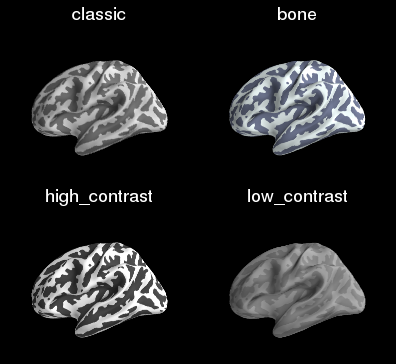Customizing the Visualization¶
One advantage to PySurfer over Tksurfer is that you are not limited to a single look for the visualization. Of course, being built on Mayavi, PySurfer is in theory completely customizable. However, we also offer a few preset options so that you do not have to delve into the underlying engine to get a different look.
Changing the display background¶
The display background can take any valid matplotlib color (i.e., it can be a tuple of rgb values, an rgb hex string, or a named HTML color).
Changing the display size¶
The default display window is 800px by 800px, but this can be configured
using the size keyword argument in the Brain constructor. size
should either be a single number to make a square window, or a pair of
values, (width, height), to make a rectangular window.
Changing the curvature color scheme¶
By default, a new Brain instance displays the binarized
cortical curvature values, so you can see which patches of cortex
are gyri and which are sulci (pass curv=False to the
Brain constructor, or use the -no-curv switch in the
command-line interface to turn this off). There are four preset
themes for the curvature color scheme, which you can pass to the
cortex parameter in the Brain constructor: classic,
bone, high_contrast, and low_contrast:

Note that, in each theme, the darker color signifies sulci.
It’s also possible to customize this further by passing the name of a mayavi colormap or a colormap name along with the endpoints of the colormap and whether it should be reversed.
Additionally, you can load a continuous curvature map with the
Brain.add_morphometry() method.
How to use these themes¶
These options can be selected either as keyword arguments to the
Brain constructor,
>>> from surfer import Brain
>>> b = Brain('fsaverage', 'lh', 'inflated', cortex='bone')
or as options in the command-line interface:
.. code-block:: bash
$ pysurfer fsaverage lh inflated -background slategray -size 400
